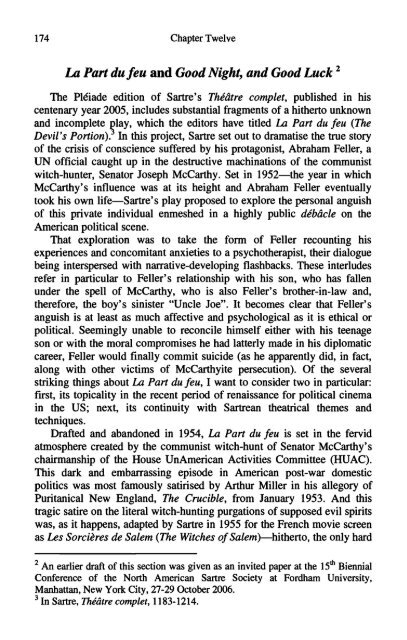Sartre's second century
Sartre's second century
Sartre's second century
You also want an ePaper? Increase the reach of your titles
YUMPU automatically turns print PDFs into web optimized ePapers that Google loves.
174 Chapter Twelve<br />
La Part dufeu and Good Night, and Good Luck 2<br />
The Pleiade edition of <strong>Sartre's</strong> Theatre complet, published in his<br />
centenary year 2005, includes substantial fragments of a hitherto unknown<br />
and incomplete play, which the editors have titled La Part du feu (The<br />
Devil's Portion)? In this project, Sartre set out to dramatise the true story<br />
of the crisis of conscience suffered by his protagonist, Abraham Feller, a<br />
UN official caught up in the destructive machinations of the communist<br />
witch-hunter, Senator Joseph McCarthy. Set in 1952—the year in which<br />
McCarthy's influence was at its height and Abraham Feller eventually<br />
took his own life—<strong>Sartre's</strong> play proposed to explore the personal anguish<br />
of this private individual enmeshed in a highly public debacle on the<br />
American political scene.<br />
That exploration was to take the form of Feller recounting his<br />
experiences and concomitant anxieties to a psychotherapist, their dialogue<br />
being interspersed with narrative-developing flashbacks. These interludes<br />
refer in particular to Feller's relationship with his son, who has fallen<br />
under the spell of McCarthy, who is also Feller's brother-in-law and,<br />
therefore, the boy's sinister "Uncle Joe". It becomes clear that Feller's<br />
anguish is at least as much affective and psychological as it is ethical or<br />
political. Seemingly unable to reconcile himself either with his teenage<br />
son or with the moral compromises he had latterly made in his diplomatic<br />
career, Feller would finally commit suicide (as he apparently did, in fact,<br />
along with other victims of McCarthyite persecution). Of the several<br />
striking things about La Part dufeu, I want to consider two in particular:<br />
first, its topicality in the recent period of renaissance for political cinema<br />
in the US; next, its continuity with Sartrean theatrical themes and<br />
techniques.<br />
Drafted and abandoned in 1954, La Part du feu is set in the fervid<br />
atmosphere created by the communist witch-hunt of Senator McCarthy's<br />
chairmanship of the House UnAmerican Activities Committee (HUAC).<br />
This dark and embarrassing episode in American post-war domestic<br />
politics was most famously satirised by Arthur Miller in his allegory of<br />
Puritanical New England, The Crucible, from January 1953. And this<br />
tragic satire on the literal witch-hunting purgations of supposed evil spirits<br />
was, as it happens, adapted by Sartre in 1955 for the French movie screen<br />
as Les Sorcieres de Salem (The Witches ofSalem)—hitherto, the only hard<br />
2 An earlier draft of this section was given as an invited paper at the 15 th Biennial<br />
Conference of the North American Sartre Society at Fordham University,<br />
Manhattan, New York City, 27-29 October 2006.<br />
3 In Sartre, Theatre complet, 1183-1214.
















